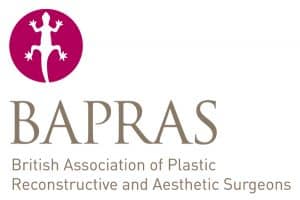
Complications
Everything you need to know regarding complications
25 Upper Wimpole Street
London W1G 6NF
Everything Regarding Complications
As with any surgical procedure, breast augmentation carries generic risks such as infection, excessive bleeding, adverse scarring. In the vast majority of cases, these are problems that can be solved/rectified with a surgical revision.
Capsular Conctracture – Encapsulation of the implant
The body reacts to the breast prostheses in the same way as with any other foreign body, that is, producing a thin fibrous capsule that completely encloses/surrounds the implant. To some extent, capsule formation is a desirable phenomenon as, by adhering tightly to the micropores of the textured surface of the silicone shell, the implant is secured in place and thus stabilized by the capsule itself.
However, in a small number of cases, over a period of months or years, the capsule can progressively become thicker and tighter, leading to a variable degree of constriction and hardening of one of the implants.
Depending on the degree of incapsulation, the aesthetic result could be compromised to a variable extent (for example, patient might experience increased roundness and firmness of the implant, upward dislocation of the implant, downward dislocation of the nipple-areola complex). In severe cases, the affected breast might be extremely hard and uncomfortable.
Almost invariably, capsular contracture only affects one of the implants, generating a variable degree of asymmetry of the breasts.
The better quality implants (Mentor and Allergan) are associated with the lowest index risk for incapsulation.
Risk Rate
Approximately 4 cases out of 100 patients
When can it happen
Generally within the first 3 years
Haematoma and Seroma
This is a collection of blood (haematoma) or serum (seroma) inside the surgical pocket; it can be of variable size and it becomes manifest with swelling, increased size/volume of one of the breasts and discomfort/pain on the affected side.
In most cases, haematomas occur within the first 48 hours post surgery as a result of the re-opening of a small blood vessel (which was sealed during the procedure) and lead to a collection of a variable amount of blood.
This is why it is important to avoid blood–thinners (Aspiring, Nurofen, Ipobrufen, Voltarol, Anti-inflammatories, over the counter pain-killers) for at least 4 weeks prior to surgery.
A small heametoma can be reabsorbed by the body, on it’s own.
A large haematoma requires drainage/evacuation in surgery.
In some cases it is possible that the body develops a collection of serum inside the surgical pocket as a result of inflammatory phenomena, as a response to the surgical trauma or as a result of mechanical trauma, that is, rubbing of the implant on the peri-prosthetic tissues. This is also why it is important to rest properly during the first 4 weeks after surgery.
Risk rate
Approximately 1 case every 100 patients
When can it happen
Usually within the firs 72 hours
Implant Rotation/Dislocation
Implant rotation is possible, especially during the first 12 months after the surgery as it normally takes one year for the body to develop enough scar tissue to secure the implant in place. Implant rotation is generally caused by arm movements which determine contraction/activation of the pectoralis muscle.
It is not always possible to reposition the prosthesis manually and in most cases a surgical procedure is made necessary.
Patients that opt for anatomical implants are made fully aware of the higher risk of rotation compared to round implants.
In cases of recurrent implant rotation, it is advisable to replace anatomical implants with round prostheses.
In some cases one of the implants can be either dislocated upwards or downwards below the submammary fold, causing a variable degree of asymmetry.
Risk rate
2 cases every 100 patients
When can it happen
Anytime
Poor Scar Quality
The poor quality of the inevitable scars, when it is not caused by infection or a wound breakdown, is strictly linked to the to the individual response, that is, to the way the individual patient heals and scars.
Risk Rate
2 cases every 100 patients
When can it happen
Usually within the first 6 months
Asymmetries
In nature, breasts are never perfectly symmetrical. Therefore there will always be a slight difference in the size, shape and position/height of the breasts following breast augmentation. Even when 2 different size implants are used, in order to try and minimize the pre-existing asymmetry, the breasts will never be perfectly identical. When it is not caused by capsular contracture, asymmetry can be the result of asymmetrical healing process, or a complication (such as infection/seroma), or can be the result of an asymmetry of the breasts, of the chest wall muscles or of the bony ribcage. These asymmetries cannot always be corrected.
Risk Rate
Depends on the pre-existing asymmetries.
When do they happen
They can become noticeable immediately after surgery, and they can improve or viceversa worsen with time.
Double Fold
It is an aeshetic issue consisting in the presence of a visible stair-step sign located 1-3 cm above the new submammary fold, in the lower pole of the breasts.
It is caused by the presence of 2 submammary folds, the new one determined by the inferior border of the implant and the old one located above.
It is determined by the lack of distension/expansion of the lower pole with insufficient coverage of the prosthesis by the gland tissue.
The cases at higher risk of developing a double fold are breasts with a higher density and firmness of the tissues, and breasts with underdeveloped lower poles (tuberous or pseudo-tuberous breasts).
In other cases it can occur as a result of ptosis/sagging of the gland over the implant and insufficient coverage of the lower pole of the implant.
In some cases it is the result of atrophy of the breast tissue as a consequence of weight loss, hormonal changes, breast feeding.
The defect cannot always be fully corrected.
Risk Rate
1 case every 100 patients
When can it happen
Usually within 3 months, however it can also happen later on in time or after breast feeding
Sensitivity changes
Quite commonly there could be a variable degree of reduction of the sensitivity of the lower quadrants of the breasts and especially of the nipple area. In most cases the change is only temporary, however in some cases it is permanent.
In other cases, there is an increase in the sensitivity caused by the distension of the nerve fibers.
In extremely rare cases there could be permanent pain even after 12 months from the procedure.
Risk rate
100 cases every 100 patients
When does it happen
Immediately after surgery, but it tends to improve with time.
Infection
This risk is extremely rare; however if infection occurs, it does involve the need to remove the infected implant and then wait at least 6 months before a new implant can be inserted. This means that for at least 6 months, the patient will have to cope with severe breast asymmetry.
The risk is higher in smokers, diabetic patients, patients that take immuno-suppressant medications, heavy weight patients and those who wet their incisions too early.
Risk rate
1 case every 1.000 patients (non-smokers)
When can it happen
Usually 1 month after surgery.
Visibility and Palpability of the implants
Especially in thin patients or in those areas of the breasts where the soft tissue coverage is not sufficient to hide the implants, it is always possible that either the border of the prosthesis or visible folds (RIPPLING) on the surface of the implant may become noticeable.
This tends to occur towards the lateral inferior quadrants of the breasts where the muscle becomes progressively thinner.
The problem cannot be solved.
Risk Rate
approx 5 cases every 100 patients.
When can it happen
Within the first 6 months or even later.
Permanent deformation or Rupture of the implant
In some cases with time there can be a deformation of the implant due to loss of cohesiveness of the silicone gel.
Implants can also rupture. Both problems can be solved with the replacement of the implants.
It is advisable to have an ultrasound scan or an MRI (Magnetic Resonance Imaging) scan of the breasts every 3 years in order to check the integrity of the implants
Risk Rate
Approx 1 case every 500 patients.
When can it happen
Usually after several years.
Ptosis – Sagginess
With time, the weight of the implants added to the weight of the breast tissue could determine progressive sagging of the breast.
In some cases the breast tissue slides downwards over the implant causing the lowering of the Nipple-Areola complex and a so-called “double-breast deformity”.
It is not possible to anticipate when this could happen as it is strictly linked to the quality of the tissue and the skin elasticity.
In these cases it might be necessary to resort to a breast uplift (mastopexy)
Risk Rate
approx 1 case every 200 patients
When can it happen
Usually after a few years, or after weight fluctuation or pregnancies
Other Complications
During the surgical procedure or in the early post-operative phase, even if extremely rare, there could be severe complications such as Anaphylactic Shock (due to a systemic allergic reaction to one of the medications) or Deep Vein Thrombosis (formation of clots usually in the lower limb veins).
Risk Rate
Approx 1 case every 2000 patients.
When can it happen
Usually either during or immediately after the procedure.
To book a consultation call 07943 277 215 or email clinic@lindafiumara.com
Complications
Everything you need to know regarding complications
Everything Regarding Complications
As with any surgical procedure, breast augmentation carries generic risks such as infection, excessive bleeding, adverse scarring. In the vast majority of cases, these are problems that can be solved/rectified with a surgical revision.
Capsular Conctracture – Encapsulation of the implant
The body reacts to the breast prostheses in the same way as with any other foreign body, that is, producing a thin fibrous capsule that completely encloses/surrounds the implant. To some extent, capsule formation is a desirable phenomenon as, by adhering tightly to the micropores of the textured surface of the silicone shell, the implant is secured in place and thus stabilized by the capsule itself.
However, in a small number of cases, over a period of months or years, the capsule can progressively become thicker and tighter, leading to a variable degree of constriction and hardening of one of the implants.
Depending on the degree of incapsulation, the aesthetic result could be compromised to a variable extent (for example, patient might experience increased roundness and firmness of the implant, upward dislocation of the implant, downward dislocation of the nipple-areola complex). In severe cases, the affected breast might be extremely hard and uncomfortable.
Almost invariably, capsular contracture only affects one of the implants, generating a variable degree of asymmetry of the breasts.
The better quality implants (Mentor and Allergan) are associated with the lowest index risk for incapsulation.
Risk Rate
Approximately 4 cases out of 100 patients
When can it happen
Generally within the first 3 years
Haematoma and Seroma
This is a collection of blood (haematoma) or serum (seroma) inside the surgical pocket; it can be of variable size and it becomes manifest with swelling, increased size/volume of one of the breasts and discomfort/pain on the affected side.
In most cases, haematomas occur within the first 48 hours post surgery as a result of the re-opening of a small blood vessel (which was sealed during the procedure) and lead to a collection of a variable amount of blood.
This is why it is important to avoid blood–thinners (Aspiring, Nurofen, Ipobrufen, Voltarol, Anti-inflammatories, over the counter pain-killers) for at least 4 weeks prior to surgery.
A small heametoma can be reabsorbed by the body, on it’s own.
A large haematoma requires drainage/evacuation in surgery.
In some cases it is possible that the body develops a collection of serum inside the surgical pocket as a result of inflammatory phenomena, as a response to the surgical trauma or as a result of mechanical trauma, that is, rubbing of the implant on the peri-prosthetic tissues. This is also why it is important to rest properly during the first 4 weeks after surgery.
Risk rate
Approximately 1 case every 100 patients
When can it happen
Usually within the firs 72 hours
Implant Rotation/Dislocation
Implant rotation is possible, especially during the first 12 months after the surgery as it normally takes one year for the body to develop enough scar tissue to secure the implant in place. Implant rotation is generally caused by arm movements which determine contraction/activation of the pectoralis muscle.
It is not always possible to reposition the prosthesis manually and in most cases a surgical procedure is made necessary.
Patients that opt for anatomical implants are made fully aware of the higher risk of rotation compared to round implants.
In cases of recurrent implant rotation, it is advisable to replace anatomical implants with round prostheses.
In some cases one of the implants can be either dislocated upwards or downwards below the submammary fold, causing a variable degree of asymmetry.
Risk rate
2 cases every 100 patients
When can it happen
Anytime
Poor Scar Quality
The poor quality of the inevitable scars, when it is not caused by infection or a wound breakdown, is strictly linked to the to the individual response, that is, to the way the individual patient heals and scars.
Risk Rate
2 cases every 100 patients
When can it happen
Usually within the first 6 months
Asymmetries
In nature, breasts are never perfectly symmetrical. Therefore there will always be a slight difference in the size, shape and position/height of the breasts following breast augmentation. Even when 2 different size implants are used, in order to try and minimize the pre-existing asymmetry, the breasts will never be perfectly identical. When it is not caused by capsular contracture, asymmetry can be the result of asymmetrical healing process, or a complication (such as infection/seroma), or can be the result of an asymmetry of the breasts, of the chest wall muscles or of the bony ribcage. These asymmetries cannot always be corrected.
Risk Rate
Depends on the pre-existing asymmetries.
When do they happen
They can become noticeable immediately after surgery, and they can improve or viceversa worsen with time.
Double Fold
It is an aeshetic issue consisting in the presence of a visible stair-step sign located 1-3 cm above the new submammary fold, in the lower pole of the breasts.
It is caused by the presence of 2 submammary folds, the new one determined by the inferior border of the implant and the old one located above.
It is determined by the lack of distension/expansion of the lower pole with insufficient coverage of the prosthesis by the gland tissue.
The cases at higher risk of developing a double fold are breasts with a higher density and firmness of the tissues, and breasts with underdeveloped lower poles (tuberous or pseudo-tuberous breasts).
In other cases it can occur as a result of ptosis/sagging of the gland over the implant and insufficient coverage of the lower pole of the implant.
In some cases it is the result of atrophy of the breast tissue as a consequence of weight loss, hormonal changes, breast feeding.
The defect cannot always be fully corrected.
Risk Rate
1 case every 100 patients
When can it happen
Usually within 3 months, however it can also happen later on in time or after breast feeding
Sensitivity changes
Quite commonly there could be a variable degree of reduction of the sensitivity of the lower quadrants of the breasts and especially of the nipple area. In most cases the change is only temporary, however in some cases it is permanent.
In other cases, there is an increase in the sensitivity caused by the distension of the nerve fibers.
In extremely rare cases there could be permanent pain even after 12 months from the procedure.
Risk rate
100 cases every 100 patients
When does it happen
Immediately after surgery, but it tends to improve with time.
Infection
This risk is extremely rare; however if infection occurs, it does involve the need to remove the infected implant and then wait at least 6 months before a new implant can be inserted. This means that for at least 6 months, the patient will have to cope with severe breast asymmetry.
The risk is higher in smokers, diabetic patients, patients that take immuno-suppressant medications, heavy weight patients and those who wet their incisions too early.
Risk rate
1 case every 1.000 patients (non-smokers)
When can it happen
Usually 1 month after surgery.
Visibility and Palpability of the implants
Especially in thin patients or in those areas of the breasts where the soft tissue coverage is not sufficient to hide the implants, it is always possible that either the border of the prosthesis or visible folds (RIPPLING) on the surface of the implant may become noticeable.
This tends to occur towards the lateral inferior quadrants of the breasts where the muscle becomes progressively thinner.
The problem cannot be solved.
Risk Rate
approx 5 cases every 100 patients.
When can it happen
Within the first 6 months or even later.
Permanent deformation or Rupture of the implant
In some cases with time there can be a deformation of the implant due to loss of cohesiveness of the silicone gel.
Implants can also rupture. Both problems can be solved with the replacement of the implants.
It is advisable to have an ultrasound scan or an MRI (Magnetic Resonance Imaging) scan of the breasts every 3 years in order to check the integrity of the implants
Risk Rate
Approx 1 case every 500 patients.
When can it happen
Usually after several years.
Ptosis – Sagginess
With time, the weight of the implants added to the weight of the breast tissue could determine progressive sagging of the breast.
In some cases the breast tissue slides downwards over the implant causing the lowering of the Nipple-Areola complex and a so-called “double-breast deformity”.
It is not possible to anticipate when this could happen as it is strictly linked to the quality of the tissue and the skin elasticity.
In these cases it might be necessary to resort to a breast uplift (mastopexy)
Risk Rate
approx 1 case every 200 patients
When can it happen
Usually after a few years, or after weight fluctuation or pregnancies
Other Complications
During the surgical procedure or in the early post-operative phase, even if extremely rare, there could be severe complications such as Anaphylactic Shock (due to a systemic allergic reaction to one of the medications) or Deep Vein Thrombosis (formation of clots usually in the lower limb veins).
Risk Rate
Approx 1 case every 2000 patients.
When can it happen
Usually either during or immediately after the procedure.
As featured in The Evening Standard and The Telegraph –










Copyright © 2025 Dr Linda Fiumara MD
Website by Createch

